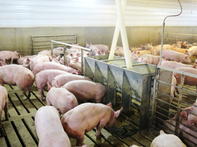Pneumonia

Pneumonia usually affects weaners and young growing piglets. According to Pigs for Profit, infection of the lungs with bacteria or viruses are usually caused by inflammation of the lungs that may be caused by dusty conditions, cold weather, foreign material, such as food or medicine, or parasites, such as worms that live or pass through the lungs.
Depending on the type of infection, pneumonia can be mild to extremely serious, causing high rates of mortalities. Signs of infection include coughing, heavy or rapid breathing, dehydration, loss of appetite, poor condition, slow and uneven growth, fever and a blue discolouration of the skin. In pigs that die of pneumonia, the lungs will be an abnormal colour and cut surfaces will ooze fluid and puss.
Parts of the lungs may also be firm like liver and sink, according to Pigs for Profit.
Treatment To prevent pneumonia, you need to prevent the underlying causes. The production area should, therefore, be kept clean, dust free and well-ventilated. Overcrowding should be prevented and steps should be taken to protect pigs from colds and draughts. Pigs should be regularly dewormed and strict biosecurity measures should be taken to keep pathogen numbers low.
There are vaccines for some types of pneumonia, but Pigs for Profit advises that these should only be used if a specific problem has been identified on your farm. Antibiotic treatment might be needed if the cause is an infection. When in doubt, ask a veterinary or animal health technician for advice.
Atrophic Rhinitis
Progressive Atrophic Rhinitis is a bacterial disease that damages the nasal lining and causes deformities in the snout. According to The Pig Site, the progressive atrophic rhinitis primarily affects younger pigs, such as piglets, weaners and growers.
Early signs include sneezing, snuffling and a nasal discharge, with the sneezing often being bloodstained. There may be a discharge from the eyes, producing a triangular stain at the inner corner of the eye. The nose and or upper jaw may become twisted, shortened and wrinkly. The piglets may lose their appetite, eat less and in effect grow poorly.
The disease may also result in pneumonia and render piglets more vulnerable to secondary infections. Sows may show no signs that they are carrying the bacteria, but their faces might be distorted.
Treatment A dusty atmosphere, poor ventilation, low humidity and toxic gasses, such as ammonia, may all predispose pigs to the development of Atrophic Rhinitis. Having a clean, well-ventilated production area will, therefore, help to prevent the disease. Overcrowding should be avoided as this may increase the risk for the development of the disease.
Good biosecurity measures will also help, since the presence of other diseases may render a pig more vulnerable to atrophic rhinitis. Sick weaner pigs can be treated with antibiotics and sows can be vaccinated to prevent the disease from being carried over to piglets.
By Glenneis Kriel